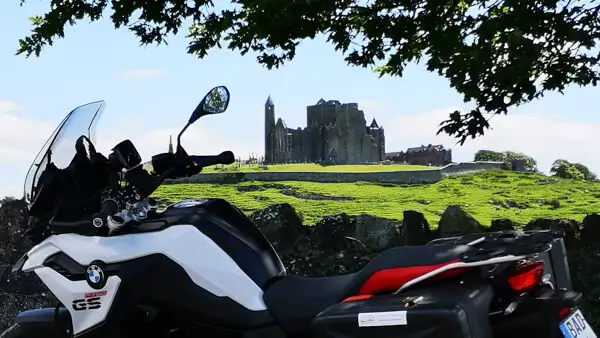The Rock of Cashel is considered one of the most important historical sights in Ireland. But why is that? That’s what this article is about….
History and background
To get straight to the point, this story is less about a rock and more about what is sitting on the rock!
The small town of Cashel is located in the province of Munster, in County Tipperary.
The surrounding countryside is essentially flat. It is called The Golden Vale because it is particularly fertile.
In the middle of this scenery, a small but steep hilltop about 65 metres high rises above the flat landscape. The small town of Cashel lies at its feet.
From the top, you have uninterrupted views for many kilometres. To the south, you can see the Knockmealdown Mountains in the distance.

To the north you can see the Slieve Bloom Mountains with the Devils Bit, a mountain that looks as if a piece has been bitten out of the top. According to legend, the devil bit into the mountain and spat the bit out again several kilometres further on – and that became the Rock of Cashel!
This exposed location with a clear panoramic view of a fertile valley was a particularly favourable strategic place to build a castle in the Middle Ages. Incidentally, Cashel is derived from the Gaelic word “Caiseal”, which means castle.
In fact, from the 4th century onwards, this castle became the seat of the kings of the great province of Munster in the south and south-west of Ireland for many years and generations.
Around the year 450, St Patrick is said to have baptised the pagan king Aenghus here.
The ruling clans at the castle changed over the centuries. In 977, Brian Boru was crowned king here at the castle. He later became the first and actually the only High King of Ireland. Around 1005, he declared himself High King. But only a few years later, in 1014, he died again – in battle against the Vikings.
But his family, the O’Briens, ruled the castle from then on.
In 1101, Ireland’s first synod was held here at Cashel. On this occasion, the then King Muircherteach O’Briain donated the castle to the Bishop of Limerick.
Cormac Mc Cartaigh then became the first Archbishop of Cashel. Together with the round tower, Cormac’s Chapel is one of the oldest existing buildings on the Rock. The beautiful chapel is built in the Romanesque style and you can still recognise relatively well-preserved Roman frescoes inside.
The bright blue colour on the ceiling frescoes is clearly visible. This is lapis lazuli, today we would call it ultramarine blue. It was an extremely rare and very precious colour pigment that was only mined in Afghanistan at the time and was shipped to Europe via Venice.
The cruciform Gothic cathedral was built in the 13th century. The tower in its centre is particularly impressive.
The ensemble of buildings also includes the bishop’s residential tower, as well as beautifully restored outbuildings such as the Vicar’s Choral. This is where the cathedral’s full-time singers lived and worked.
From 1571, Miler McGrath held the title of Archbishop of Cashel. Miler was indeed a colourful personality, he was probably the most notorious bishop of his time . Before coming to Cashel, he was a Catholic bishop in north-east England.
Seeking a change, he visited Queen Elizabeth I in England. However he persuaded her, she made him the Protestant Archbishop of Cashel, which was part of her dominion.
For a few years, Miler was both a Catholic bishop and a Protestant one, until the Pope in Rome had had enough of his machinations and excommunicated him. Miler cared little for this. He kept pigs in his cathedral, preached whatever came into his head and did his mischief on the rock.
At a time when most people died young due to epidemics or wars, Miler survived two assassination attempts and finally died of natural causes at the age of almost 101. “The Scoundrel of Cashel” left behind two wives and 9 children. “He was a good Irishman!”
Conclusion
I live in the south-east of Ireland (second home) and have been to the Rock of Cashel several times. We are originally from Germany.
When you get to the Rock of Cashel, the first thing that catches your eye is the impressive location of the castle. At the top you have a very nice view, but in view of the roofless cathedral, you could quickly be “done” with the visit. Be sure to take part in a guided tour here, you will get a deeper connection to this place. You will find more information here: https://heritageireland.ie/places-to-visit/rock-of-cashel/.
Enjoy the Rock of Cashel!
More interesting articles for you
THE AMAZING KILKENNY CASTLE
THE REBELLIOUS TOWN OF ENNISCORTHY
BLARNEY CASTLE AND THE STONE OF ELOQUENCE
CAHIR CASTLE – A STAR AMONG THE CASTLES
Image credit cover picture: Photo by Mike Kenneally on Unsplash
